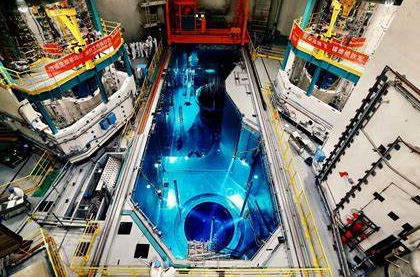An energy crisis, activate the global trillion nuclear power market
Starting from the capital Jakarta in the north and the famous city Bandung in West Java in the south, the Jakarta-Bandung high-speed railway with a total length of 142 kilometers is the first high-speed railway in Indonesia and even the entire Southeast Asia region, and is also a landmark project of strategic docking and joint construction of the Belt and Road between China and Indonesia.
Just as China's high-speed rail is going abroad along the Belt and Road, China's nuclear power is being replicated along this path.
In recent years, China's independent research and development of three generations of nuclear power technology "Hualong one" has been stepped out. In addition to the K2 and K3 projects that have been completed and put into operation in Pakistan, in February last year, the UK also confirmed the use of "Hualong One" for the construction of Bradwell B nuclear power plant.

From a global perspective, only the United States, Russia, France, China, South Korea and Japan have the strength to export third-generation nuclear power units. In comparison, China has obvious advantages in terms of technical level and unit cost. In particular, the high temperature gas cooled reactor technology in the fourth generation technology ranks in the forefront of the world.
According to the China Nuclear Grid, five of the world's top 10 nuclear power plants are in China.
In terms of cost, it's like lithium. China has the most competitive battery pack cost, only $127 per kWh ($127/kWh), the United States and Europe are 24% and 33% higher than China, respectively, transmitted to the vehicle link, there is obvious manufacturing and price competitiveness.
The same is true of nuclear power.
Taking China's third-generation nuclear power unit "Hualong One" as an example, the construction cost is about 16,000 yuan/kilowatt, which is 20%-30% lower than that of foreign countries, and the cost will further decline with the subsequent mass construction and technology improvement.
At present, CNNC has reached cooperation intentions with 20 countries, including Argentina, the United Kingdom and Pakistan, and CGN has reached cooperation intentions with the Czech Republic, Romania and France. In addition, CNNC and CGN are also working with partners to explore the nuclear energy market in Europe, Central Asia and Southeast Asia.
Data show that by 2030, among the countries along the Belt and Road, more than 20 countries and regions with plans to develop nuclear power will build 107 nuclear power units, with a total of 115 million kilowatts of new nuclear power installed capacity. Apart from the Chinese market, these countries and regions account for 81.4% of the increase in the world nuclear power market.
Moreover, the nuclear power construction industry chain is long, the investment amount is high, and the spillover effect is more obvious.
According to the National Energy Administration, each export of a nuclear power unit can drive the sales of more than 60,000 sets of equipment, more than 200 enterprises on a chain can create about 150,000 jobs, and drive more than 5,300 enterprises in the upstream and downstream industry chain.
05 Storage trend: Small piles become a must, nuclear energy + promising
The single investment of large nuclear power units is about 20 billion to 30 billion yuan, which has the characteristics of typical heavy capital and heavy technology investment, and involves major national security, and the construction cycle is more than 5 years, and private enterprises are rarely involved.
- EMERSON
- Honeywell
- CTI
- Rolls-Royce
- General Electric
- Woodward
- Yaskawa
- xYCOM
- Motorola
- Siemens
- Rockwell
- ABB
- B&R
- HIMA
- Construction site
- electricity
- Automobile market
- PLC
- DCS
- Motor drivers
- VSD
- Implications
- cement
- CO2
- CEM
- methane
- Artificial intelligence
- Titanic
- Solar energy
- Hydrogen fuel cell
- Hydrogen and fuel cells
- Hydrogen and oxygen fuel cells
- tyre
- Chemical fiber
- dynamo
- corpuscle
- Pulp and paper
- printing
- fossil
- FANUC
- Food and beverage
- Life science
- Sewage treatment
- Personal care
- electricity
- boats
- infrastructure
- Automobile industry
- metallurgy
- Nuclear power generation
- Geothermal power generation
- Water and wastewater
- Infrastructure construction
- Mine hazard
- steel
- papermaking
- Natural gas industry
- Infrastructure construction
- Power and energy
- Rubber and plastic
- Renewable energy
- pharmacy
- mining
- Plastic industry
- Schneider
- Kongsberg
- NI
- Wind energy
- International petroleum
- International new energy network
- gas
- WATLOW
- ProSoft
- SEW
- wind
- ADVANCED
- Reliance
- YOKOGAWA
- TRICONEX
- FOXBORO
- METSO
- MAN
- Advantest
- ADVANCED
- ALSTOM
- Control Wave
- AB
- AMAT
- STUDER
- KONGSBERG
- MOTOROLA
- DANAHER MOTION
- Bently
- Galil
- EATON
- MOLEX
- Triconex
- DEIF
- B&W
- ZYGO
- Aerotech
- DANFOSS
- KOLLMORGEN
- Beijer
- Endress+Hauser
- MOOG
- KB
- Moxa
- Rexroth


Email:wang@kongjiangauto.com


















































































































